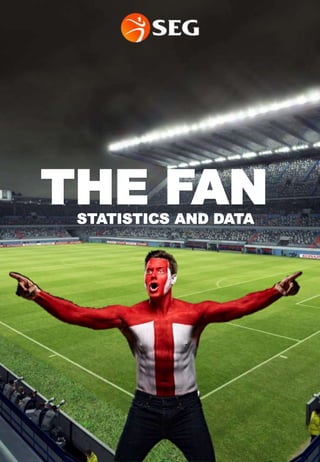Football a commercial perspective
- 1. THE FANSTATISTICS AND DATA
- 2. ŌĆ£Some people can only see LED perimeter advertising, but what every company should follow is building an association between the brand and the consumer through emotional connection. Media exposure is vital to amplify brand story-telling. If people do not know that a brand is a Champions League sponsor, there are small chances to affect their consumption behavior, because fans do not have to tendency to choose brands they do not know.ŌĆÖŌĆÖ 1:6 ŌĆ×We know that the beautiful game has the power to unite like no other sport ŌĆō and connecting people and their passions is a very big part of what we do. In terms of measuring a return on investment, we conduct regular media evaluation on our sponsorship assets. This looks at a number of factors, but mostly focuses on the value of television exposure. We would normally expect somewhere in the region of a 6-1 return on our sponsorships ŌĆō that is $6 worth of TV exposure for every $1 invested. We also carry out studies in different markets to determine how effective the investment has been from an awareness and engagement point of view and whether we need to do more to produce the right results. ŌĆ× Sursa : Insights by Repucom
- 3. Football games and sports in general have been at the core of the development and profitability of the media industry for over 50 years. Starting with the huge audiences attracted by sport events in front of the magic black box, which evolved from black and white images to 4K and finishing up with fan battles on social media and mobile broadcasting, global and national brands and football fans have always felt the emotions of competitions together. On a global level, brands focus on the World Cup, the European Championships and other continental competitions, such as the Champions League or the Europa League, which manage to attract homogeneous audiences in terms of preferences and heterogeneous audiences in terms of geographical markets. These competitions have the advantage of a global exposure, which can be hardly achieved through classical TV advertising. How does the global football consumer look like? Who is the person to whom brands are communicating? According to ŌĆ£InsightsŌĆØ by Repucom, the global football fan is a man, between 16 and 44 years old, with an above average education. The football lover is different to other people around him, but he is exactly what brands are looking for, an active man. He practices sports, travels and has an active social life, being often seen at concerts, events and at the cinema. The global fan is well ahead of everyone else in terms of information, digesting 25% more media than an usual person and therefore, he has a high appetite for consume and is ready to pay for his passions.
- 4. The supporter is the most important ingredient of any sport. Here, every penny spent and every decision made revolves around the fan. Understanding who and where the fans are and why they support their favourites is essential for any sport related commercial activity. The fans are the fuel of the industry. They are the central point of the commercial universe of sports. 64% 36% MALE FEMALE GENDER EDUCATION LOW MEDIUM HIGH 15% 40% 45% DEMOGRAPHICS 16-24 25-34 35-44 45-54 55-69 20% 28% 20% 18% 13% SINGLE IN A RELATIONSHIP MARRIED 35% 12% 54% THE GLOBAL FOOTBALL CONSUMER Sursa : Insights by Repucom
- 5. The way in which sport is consumed is constantly changing. Today, technology brings fans closer to the sport more than ever. They can choose not only the type of sport content they want, but also the way the way to consume it ŌĆō anytime and anywhere. Fans and emergent markets are more and more associated with sport, more than anywhere else around the world. INTERESE TRAVEL FILMS AND MUSIC TV SPORTS SPORTS IN GENERAL AVERAGE PERSON FOOTBALL FAN INTERESTS 80% 78% 76% 74% 75% 71% 55% 53% MEDIA CONSUMPTION FOOTBALL FANAVERAGE PERSON 75% 76% 90% 46% 60% 65% 33% 32% 45% 49% mobile tv radio print internet INTERESTS Source : Insights by Repucom THE GLOBAL FOOTBALL CONSUMER
- 6. EDUCATION UNIVERSITY OTHER DEGREE HIGH SCHOOL 23% 45% 32% SINGLE OTHER MARRIED 31% 12% 57% CIVIL STATUS AGE 14-24 25-34 35-44 45-54 55-69 19% 20% 20% 17% 24% 77% 23% MALE FEMALE DEMOGRAPHICS Source : SNA Focus, 14-74 urban THE ROMANIAN FOOTBALL CONSUMER
- 7. Brands that communicate locally through sport follow the line between distribution and sales, so they focus on the specificity of each geographical area. A team can be supported by a national or a local brand (which covers only a region or a town) ŌĆō everything depends on the fansŌĆÖ disposable income and purchasing power. In Eastern Europe, the budget of each fan is still small and 80% of it is focused on covering household expenses and ensuring a decent lifestyle. In Romania, according to the National Audience Study (SNA Focus), the average football fan is a married man, with an above average education, between 14 and 44 years old and above average income. The Romanian football consumer is similar to the global consumer. Project Team Victor Voicu Catalin Boier Cristian Gheorghe







